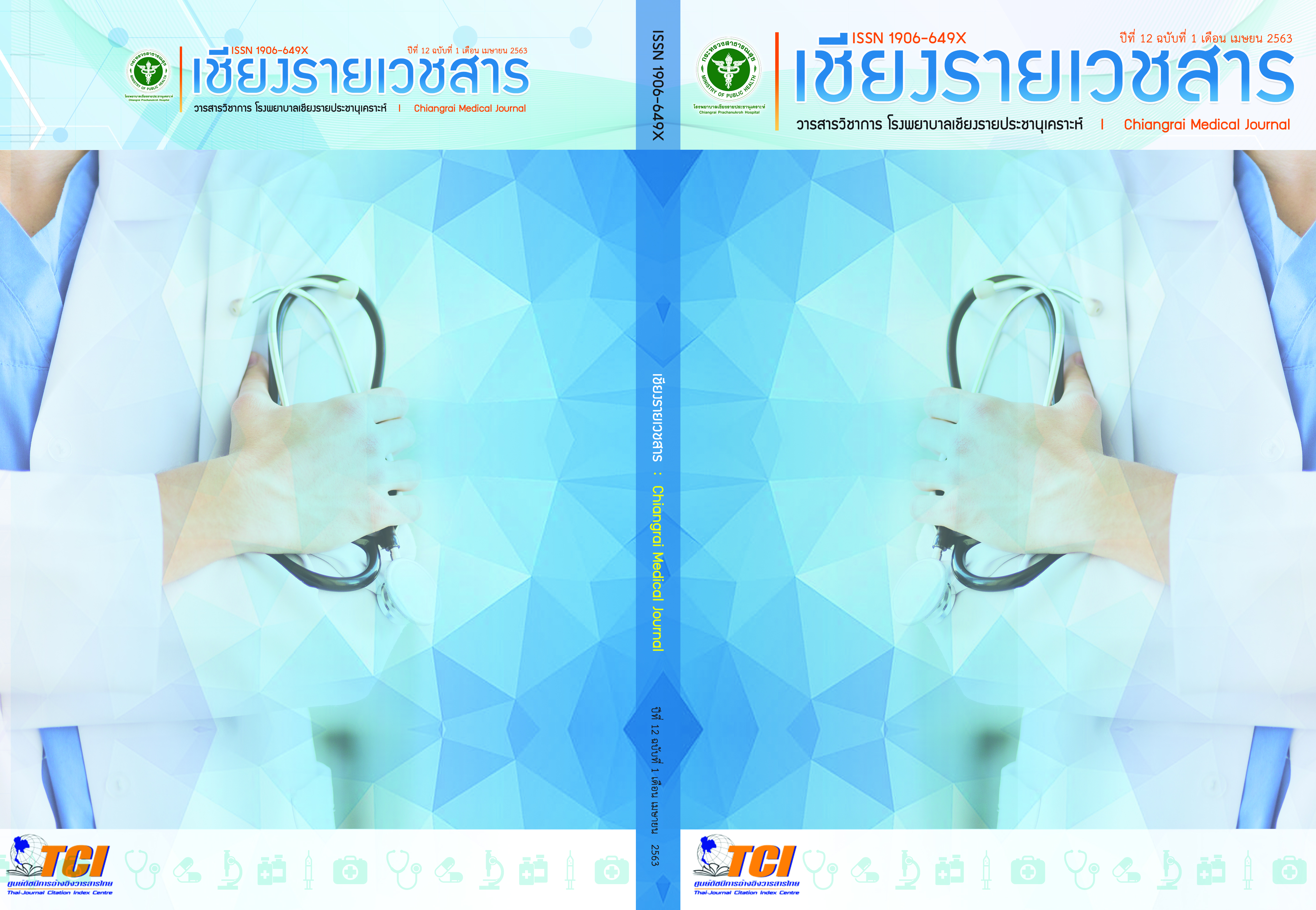Risk factors of relapsed or refractory of the treatment of diffuse large B-cell lymphoma in Chiangrai Prachanukroh Hospital
Main Article Content
Abstract
Risk factors of relapsed or refractory of the treatment of diffuse large B-cell lymphoma in Chiangrai Prachanukroh Hospital
Piyapong Kanya,MD., Piyaporn, Sirijanchune, MD., Nonlawan Chueamuangphan, MD., Ph.D.
ABSTRACT
BACKGROUND
Diffuse large B-cell lymphoma (DLBCL) is the most common lymphoma in Thailand. One-third of patients had a condition either refractory to initial treatment or relapse after standard regimen.
OBJECTIVES
Primary outcome was risk factors of relapsed or refractory of DLBCL with a standard treatment regimen. Secondary outcomes were 3-year overall survival (OS) of DLBCL and lymphoma incidence characteristic patterns defined by the World Health Organization (WHO) 2008 subtype.
METHODS
A retrospective cohort study of DLBCL patients at Chiangrai Prachanukroh Hospital from January 2013 to December 2019. Data collection was reviewed from medical records. The cox proportional hazards models were used to estimate the hazard ratio and 95% confidence intervals (CI) associated with the risk factors of relapsed or refractory DLBCL. P-value < 0.05 was considered statistically significant.
RESULTS
There were 101 patients with DLBCL with a mean age of 58.82 years. Forty-one patients (40.59%) had a condition of relapsed or refractory DLBCL. The risk factors of relapsed or refractory DLBCL were Ann Arbor stage III-IV (HR 2.21; 95% CI 1.06-4.62, p=0.035) and elevated lactate dehydrogenase (LDH) level [hazard ratio (HR) 4.01; 95% CI 1.66-9.68, p=0.002]. Patients with Ann Arbor stages I-II had better 3-year OS compared to Ann Arbor stage III-IV (74% and 46% respectively, p=0.005). Patients with normal serum LDH had better 3-year OS compared to high serum LDH (75% and 52% respectively, p=0.008). The common lymphoma incidence characteristic patterns defined by WHO 2008 subtype were DLBCL, Extranodal marginal zone B-cell lymphoma of mucosa-associated lymphoid tissue [MALT-lymphoma] and Peripheral T-cell lymphoma, not otherwise specified (PTCL, NOS) (51.80%, 9.23%, and 6.15% respectively).
CONCLUSIONS AND DISCUSSIONS
The risk factors of relapsed or refractory of DLBCL treatment were Ann Arbor stage III-IV and elevated LDH level. The evaluation of Ann Arbor staging and serum LDH were essential categories to predict prognosis and treatment outcome.
KEYWORDS: Relapsed or refractory DLBCL, Risk factors, LDH, Ann Arbor staging.
Article Details
References
2. Bunworasate U, Siritanaratkul N, Khuhapinant A, et al. A nationwide prospective multicenter study of clinical features and outcomes on non-Hodgkin lymphoma in Thailand: an analysis of 939 cases. Blood 2011;118(Suppl. 1): Abstract 2064.
3. Sehn LH, Donaldson J, Chhanabhai M, et al. Introduction of combined CHOP plus Rituximab therapy dramatically improved outcome of diffuse large B-cell lymphoma in British Columbia. J Clin Oncol. 2005;23(22):5027-5033.
4. Coiffier B, Thieblemont C, Van Den Neste E, et al. Long-term outcome of patients in the LNH-98.5 trial, the first randomized study comparing Rituximab-CHOP to standard CHOP chemotherapy in DLBCL patients: a study by the Groupe d’Etudes des Lymphomes de l’Adulte. Blood.2010;116(12):2040-2045.
5. Larouche JF, Berger F, Chassagne-Clement C, et al. Lymphoma recurrence 5 years or later following diffuse large B-cell lymphoma: clinical characteristics and outcome. J Clin Oncol. 2010;28(12):2094-2100.
6. A predictive model for aggressive non-Hodgkin’s lymphoma. The International Non-Hodgkin’s Lymphoma Prognostic Factors Project. N Engl J Med. 1993;329(14):987-994.
7. Shipp, et al. A predictive model for aggressive non-Hodgkin's lymphoma. N Engl J Med. 1993;329(14):987-994.
8. Zhou Z1, Sehn LH, Rademaker AW, et al. An enhanced International Prognostic Index (NCCN-IPI) for patients with diffuse large B-cell lymphoma treated in the Rituximab era. Blood. 2014 Feb 6;123(6):837-842.
9. R.Vaidya, T.E. Witzig. Prognostic factors for diffuse large B-cell lymphoma in the R(X)CHOP era. Ann Oncol. 2014; 25(11): 2124-2133.
10. Pfreundschuh M1, Trümper L, Osterborg A, et al. CHOP-like chemotherapy plus Rituximab versus CHOP-like chemotherapy alone in young patients with good-prognosis diffuse large-B-cell lymphoma: a randomised controlled trial by the MabThera International Trial (MInT) Group. Lancet Oncol. 2006;7(5):379-391.
11. Coiffier B1, Lepage E, Briere J, et al. CHOP chemotherapy plus Rituximab compared with CHOP alone in elderly patients with diffuse large-B-cell lymphoma. N Engl J Med. 2002;346(4):235-242.
12. Rosenwald A, Wright G, Chan WC, et al. The use of molecular profiling to predict survival after chemotherapy for diffuse large-B-cell lymphoma. N Engl J Med. 2002;346(25):1937-1947.
13. Shipp MA, Ross KN, Tamayo P, et al. Diffuse large B-cell lymphoma outcome prediction by gene-expression profiling and supervised machine learning. Nat Med. 2002;8(1):68-74.
14. Intragumtornchai T, Bunworasate U, Siritanaratkul N, et al. Inferior progression-free survival for Thai patients with diff use large B-cell lymphoma treated under Universal Coverage Scheme: the impact of Rituximab inaccessibility. Leukemia and lymphoma. 2013; 54(1): 83–89.
15. George DG, Matthew NM, Kamran AA, et al. Radiotherapy for early stage diffuse large B-cell lymphoma with or without double or triple hit genetic alterations. Leuk Lymphoma. 2019; 60(4): 886–893.
16. Norasetthada L, Nawarawong W, Lekhakula A, et al. Consolidation Radiotherapy Improved Survival in Limited Stage Diffuse Large B-Cell Lymphoma (DLBCL): A Nationwide Multi-Institutional Registry of 816 Cases in Thailand. Blood.2015;126 (23): 2712.
17. Fluge Ø, Mannsåker B, Torp A, et al. Consolidative Radiotherapy to Residual Masses After Chemotherapy Is Associated With Improved Outcome in Diffuse Large B-Cell Lymphoma. A Retrospective, Population-Based Study. Clin Lymphoma Myeloma Leuk. 2018;18(2):125-135.e3.
18. Yap E, Law ZK, Aslan Abdullah NM, et al. Consolidation radiotherapy for advanced-stage aggressive B-cell non-Hodgkin lymphoma: A systematic review and meta-analysis. EXCLI J. 2017; 16: 1233-1248.
19. Campo E, Swerdlow SH, Harris NL, et al. The 2008 WHO classification of lymphoid neoplasms and beyond: evolving concepts and practical applications. Blood. 2011;117(19):5019-5032.
20. Cheson BD, Fisher RI, Barrington SF, et al. Recommendations for initial evaluation, staging, and response assessment of Hodgkin and non-Hodgkin lymphoma: the Lugano classification. J Clin Oncol. 2014 Sep 20;32(27):3059-3068.
21. Ichiki A, Carreras J, Miyaoka M, et al. Clinicopathological Analysis of 320 Cases of Diffuse Large B-cell Lymphoma Using the Hans Classifier. J Clin Exp Hematop. 2017;57(2):54-63.
22. Chang ST, Chen SW, Ho CH, et al. Immunophenotypic and genetic characteristics of diffuse large B-cell
lymphoma in Taiwan. Journal of the Formosan Medical Association. 2016; 115: 961-967.


